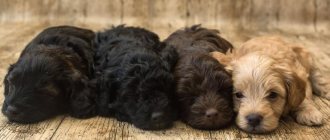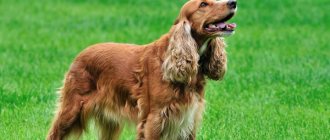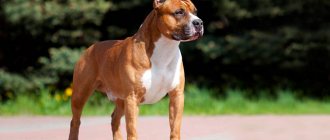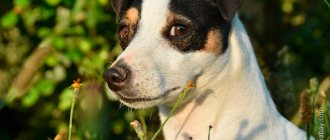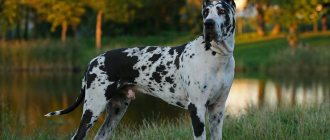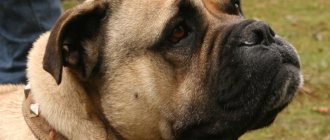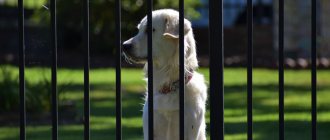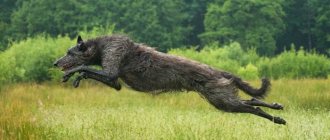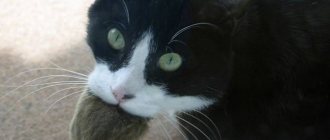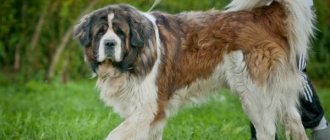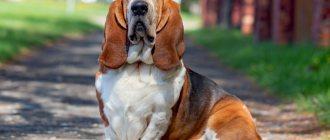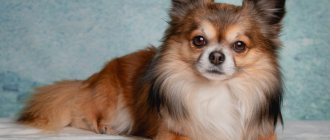Spaniels are a group of hunting dogs for catching water and land game. Modern dogs are less adapted to their main job, but remain loyal friends, cheerful, kind pets, and children's favorites. Many believe that the true homeland of Spaniels is England, but in fact the first hunters appeared in the Spanish lands.
Any spaniel needs training and education, careful grooming, and proper selection of food. You should not choose a breed from this group if the family is not ready for frequent active walking.
English cocker
The breed originated with Norfolks, ancient dogs with hunting abilities. It was from them that two different branches of Spaniels came - heavy Springers and medium-sized (up to 41 cm at the withers) Cockers. They hunt birds.
Most likely, the standard appearance of the Spaniel, which everyone knows, refers precisely to the English Cockers: these are small stocky dogs with a wide loin, a long body, a wedge-shaped muzzle, large drooping ears, and wavy hair. Animals have a good sense of smell thanks to their large sensitive nose and good eyesight. The breed is subject to strict standards. Which you can find in a detailed article about the English Cocker.
A hunting working dog that has migrated to a person’s apartment quickly gains weight due to a lazy lifestyle. Although initially Spaniels are real athletes: fast, agile, strong, fit. Without proper care and education, a pet becomes lazy.
Dogs are family men, they love people, they treat children well, but they are wary of strangers and rarely get along with cats and small animals. Pets are sensitive to the mood of the owner and the atmosphere in the house. They need a loving family with an active lifestyle. The average cost is 10,000-20,000 rubles.
Education, training, coaching
Training the Russian Hunting Spaniel is easy. Smart and efficient, these shaggy “bundles of energy” quickly understand what is required of them and are almost not prone to whims. In addition, spaniels have an excellent memory for words, which is already quite valuable. However, you should not overload your dog with various training courses. The Russian Hunting Spaniel is primarily a hunter and tracker, for which five basic commands are enough for full-fledged work.
Raising a baby begins after moving to a permanent owner, and the first thing the baby needs to figure out is identifying the identity of the owner. In the future, it is this person who will be able to control the dog’s behavior both during hunting and in everyday life, therefore, in the first month after the puppy appears in the house, its basic needs should be satisfied by only one family member.
Accustoming to a nickname begins from the first days after moving from the nursery. But don’t overdo it: the animal’s name should not become synonymous with the call “Come to me!” The next stage is mastering the commands: “Place!” (worked out first), “You can’t!” and “Take it!” This is no longer just behavior management, but also preparation for subsequent training. Keep in mind: the life of a Russian hunting spaniel that has not learned basic commands will be short-lived.
A necessary skill for hunting individuals is to fulfill the “Give it!” requirement. Dogs master this skill easily, since the passion for fetching objects is in the breed’s blood. But it’s one thing to fetch a ball and quite another to drag a shot grouse, so stock up on duck wings and tufts of feathers in advance to throw them to the dog instead of toys.
A more significant alternative to wings is a bird carcass frozen from the last hunting season. However, according to experienced dog lovers, the method does not always work as it should. In particular, having trained on a frozen bird, the Russian spaniel loses interest in warm prey. In such cases, it is recommended to put the patient on a strict diet (1-2 days). A fairly hungry spaniel quickly forgets about the feeling of disgust and works with fresh game as it should.
Picking up a shot bird from the water and its subsequent removal is handled in the same way as a regular offering of a bird. The only difference is that this time the wing or stuffed animal will be thrown into the water. It is better to start training in the summer, when the water is warm, and continue until the fall, so that the dog hardens. In general, you can practice serving with a Russian hunting spaniel as early as 3 months. But with full training you will have to wait until the pet has learned the basic obedience commands. This usually happens by 4-5 months.
Among professional hunters, there are often cases of purchasing adult Russian spaniels with subsequent training. This is done in order to “skip over” the childhood and teenage periods, when a lot of time, effort and financial resources are spent on raising and socializing a puppy. Of course, it is much more difficult to train and train grown individuals, but this is a feasible task for a specialist who has experience communicating with the breed. By the way, it is quite possible to raise a champion from an adult dog who will award the owner with working diplomas and certificates of honor.
English springer
The breed can be called the progenitor of all living Spaniels - the most ancient companion and hunter of the English nobility is the Springer. A large dog, reaches 46-56 cm at the withers and weighs up to 30 kg. Stately, muscular, strong, but graceful in movement, light and fast . Dogs were especially popular during the Renaissance: great artists painted them on canvas and described them in novels.
Currently, two types of Springers are bred: working hunters and show decorative dogs. They are not very different in appearance, but have different abilities and degrees of development of instincts.
A good family pet: kind, loyal, active, devoted . The best friend for children, a partner for running and playing. Suitable for active people with free time for walking and hunting.
Springers cannot be left alone for a long time: they begin to whine, bark, and destroy everything around them. Recently, there has been a tendency towards increased incidence of rage syndrome. This is a neurological disease related to epilepsy. At the moment of an attack, the dog does not distinguish between commands and does not understand where it is, and attacks its owners for no reason.
Interesting facts about Russian hunting spaniels
Russian spaniels have many talents and hunting skills, which can be observed by opening a treasure trove of interesting and educational facts about these amazing and smart four-legged animals; we will list some of them.
This dog breed is the youngest bred in our country. This is the only Russian gun hunting breed. The Russian Spaniel combines many of the qualities, features and characteristics of Cockers and Springers. Where the spaniel has settled, all sharp and strong odors should be excluded so as not to spoil the hunting dog's sense of smell.
The fur of Russian spaniels has almost no odor, which will undoubtedly be appreciated by many dog breeders. This breed was recognized only by the Union of Public Cynological Organizations of the Russian Federation (RKF); Russian Spaniels were never recognized at the international level. It was spaniels that Nicholas I adored; he had a dog named Hussar. The hussar was always the king's faithful companion, they even had breakfast together.
Scientists believe that dogs similar to spaniels were used in hunting back in the 10th century. When a whole group of hunters is hunting at once, one spaniel is able to obey all their commands and tries to carry them out clearly and competently. In 1858, the media first mentioned the Russian hunting breed of spaniels.
Spaniels have innate resilience and fearlessness; even small puppies will not run away when they see an unfamiliar large dog, and they are not afraid of a loud, piercing sound.
American Spaniel
The embodiment of charm and grace is the American Cocker. The breed has a long history, starting in the yards of England, where the first Cocker Spaniels were bred. The first standard dog named Obo belonged to the breeder James Furrow, who created a kennel and sent two puppies to America: Obo 1 and Chloe 2.
After mating, strange puppies with big eyes were born; they were not appreciated at an exhibition in the UK, but a new branch of Cockers was born in the USA. Since 1935, English and American representatives have not mixed and are considered different breeds.
American spaniels are more intended for family life and differ from their ancestors in several ways:
- Smaller height (about 3 cm);
- Unstable character, constantly changing mood;
- Snub-nosed deep muzzle;
- Curly-like flowing coat.
These dogs can become hunters of hares or game, but would rather not want to get dirty or run for a long time through the forest. They like to spend time with the owner and household members, play active games, and be with children. American Cockers are fine with living in an apartment. The average price for puppies is 60-80 thousand rubles.
Caring for Russian Hunting Spaniels
Careful care is required for the coat of Russian Spaniels, which shed twice a year. It is necessary to constantly comb the dog's coat; it is better to do this a couple of times per week with a special metal brush, this eliminates the formation of tangles and an unkempt, disheveled appearance. Combing should be done according to hair growth.
It is better to bathe spaniels once or twice a month. This is done using a special shampoo-conditioner, which is sold in pet stores. To treat the coat after water procedures, use a special balm or cosmetic oil to make the coat silkier and give it elasticity. Spaniels are given a haircut; they do it for the first time starting from the age of three months.
There are two types of haircuts. Full, which is done every couple or three months by a groomer. And also hygienic, carried out every two weeks, here the elimination of overgrown hair in the area of the paws, near the anus and auditory openings takes place.
It is worth noting that it is prohibited to cut wool on the ridge; it is only combed there. The Spaniel's large, floppy ears need to be checked and aired regularly. Ventilation is carried out by flapping the ears, like wings, for several minutes. Cleaning the ears is done once a month with a cotton swab moistened with water or a weak solution of hydrogen peroxide. If the spaniel is healthy, then there will be no unpleasant odors from the ears and large accumulations of wax.
Healthy dog eyes should be clean and not teary; it is recommended to wipe them once a week with tea leaves or chamomile infusion. Nails are trimmed monthly (once) using a nail clipper. Once a month, spaniels need to be treated with special preparations that counteract ticks and fleas, which are applied to the withers area.
Of course, one of the main procedures for Russian spaniels is walking; these dogs cannot live without long and active walks, which it is preferable to go on two or even three times a day. The duration of the festivities should be at least an hour, and, at best, take a couple of hours, then the dog will be happy and incredibly grateful.
American Water Spaniel
The breed is not very widespread in the world, but is popular in its homeland - the USA. Small curly dogs of brown color, reaching 38-46 cm at the withers. There is a version that the animals originated from the Irish Water Spaniel (confirmed by the similarity of appearance) or from the Curly-Coated Retriever. One way or another, this symbol of the state of Wisconsin does an excellent job of hunting hare and waterfowl.
The dog is very hardy: it is not afraid of cold, ice water, wind, heat. But at the same time, the breed is characterized by serious genetic diseases (dermatitis, weakened bones, problems with the eyes, nervous and skeletal systems).
This is an intelligent, perceptive pet with good instincts that is easy to train. Animals quickly become attached to their owner and protect his family and home. Spaniels are good swimmers, fast and agile. The average price for puppies is 55-65 thousand rubles.
Character of the Russian Spaniel
Persistent and tireless in work, in a home environment the Russian hunting spaniel is transformed, transforming into a pleasant, good-natured pet. Moreover, with this shaggy psychotherapist you can always whisper about secrets or spend the evening watching the “Hunter and Fisherman” channel. In everyday life, a Russian spaniel doesn’t care what to do, as long as it doesn’t lose contact with its owner.
Even into adulthood, representatives of the breed retain puppy playfulness and interest in entertainment. This helps them join children's groups, in which long-eared gamers feel like fish in water. By the way, dogs do not conflict with babies, generously forgiving her for minor harms like pulling her tail and ears.
The Russian Hunting Spaniel's favorite games are fetching all kinds of balls and, of course, searching for objects, so don't be lazy to devote at least 10-20 minutes a day to your pet's hobbies. However, you don’t have to do this, but then you need to calmly accept the fact that the dog will have fun on its own. Typically, Russian hunting spaniels compensate for the lack of play with destructive behavior, so just to be on the safe side, hide your Nikes and Adidas shoes away. Spaniels love to chew leather products and anything that even slightly resembles it.
The breed has a very developed intuitive sense: its representatives easily detect changes in the owner’s mood, understand any requirement at a glance, and masterfully differentiate all people into good and suspicious people. If a spaniel growls with enviable consistency at one of your old friends, there is reason to think about it.
Dutch Spaniel (Koikerhondje)
An interesting small breed that has retained its hunting skills and instincts. Dogs appeared in Holland and were named after natural functions. Koikrhondier literally means “duck hunter”. This is an excellent gun dog with a unique working style. Typically, “aquatic” animals specialize in offering killed game. Dutch spaniels wag their tails and “dance” to attract ducks to the shore, where the owner has already set traps. This type of hunting is called tolling.
Koikes are calm, reserved, non-aggressive, and do not like to bark . The dog becomes strongly attached to its owners, but is indifferent to children and cannot tolerate mockery or loud screams. The breed is suitable for active owners who have free time for long walks and training.
The working skills of these animals do not need to be revealed, their instincts work too well. Breeders have to cope with constant escapes (chasing cats and rodents), a dug up yard, and frequent bathing (Koikes are lovers of unpleasant odors and wallowing in trash).
The average cost for the breed is 30-60 thousand rubles.
Pros and cons of Russian hunting spaniels
Every beloved pet is not only a true friend for its owner, but also a faithful companion, an invaluable companion, who has a number of positive qualities that overshadow all minor shortcomings and flaws. If you look objectively and impartially, then any breed has certain disadvantages and advantages, this also applies to Russian spaniels, which are no exception in this regard.
Russian hunting spaniels are simply created for energetic and active people who try to spend all their free time in the lap of nature. For lovers of hunting, this dog will bring not only great joy and pleasure from communication, but also considerable benefits. For homebodies and passive viewers of the television screen, such a breed will be a burden, because their interests will radically diverge. Let's try to give a list of the advantages and disadvantages of this Russian breed.
The advantages of the Russian spaniel include:
- Friendliness, playfulness and perky disposition;
- Ability to establish contacts with children;
- Having boundless courage and devotion;
- Rare aggression shown in extreme cases;
- The Spaniel is a dog suitable for apartment living conditions;
- Possessing excellent sense of smell and outstanding hunting talent;
- The animal's fur has almost no odor.
The disadvantages of Russian spaniels include:
- Their demands for daily and fairly long walks;
- Manifestation of hyperactivity;
- Having long hair and floppy ears that require regular grooming;
- Excessive gluttony, spaniels are not familiar with the feeling of satiety, it is necessary to ensure that the dog is not overfed, this can lead to obesity;
- Spaniels can often experience food allergies.
Irish Water Spaniel
A dog with luxurious curly waterproof coat (brown color), designed for hunting on the shore and in the water. Irish Water Spaniels are large and heavy (up to 59 cm at the withers with a weight of up to 35 kg). They are not recommended to be kept in an apartment. Animals need fresh air, active jogging, and swimming in open water. It is important for them to realize their hunting abilities.
The main disadvantage of the breed is cowardice, which can develop into aggression, which is why children usually do not have Water Spaniels.
With proper upbringing, the pet becomes affectionate, obedient, and devoted. The dogs are rare, so the average cost is 50-60 thousand rubles.
Health and diseases of Russian hunting spaniels
The breed does not suffer from serious genetic diseases, but, like any other dog, the Russian Hunting Spaniel is capable of contracting an infection. For example, animals that often have to dive into ponds and swamps for killed game are at risk of contracting leptospirosis, an acute infection accompanied by damage to the capillaries, liver and kidneys. Quite often, dogs suffer from fungal diseases such as dermatomycosis, as well as parasitic infections such as toxoplasmosis and helminthiasis.
The long, floppy ears of Russian Spaniels can also cause a lot of problems, since such “designs” are ideal for the development of otitis media. Individuals who bathe frequently are especially susceptible to the disease: getting water inside the ear canal is an almost guaranteed inflammation. In addition, the breed has a pathological tendency to be overweight, aggravated by food allergies, which requires the owner to take a careful approach to selecting food and painstakingly create a menu.
Cavalier King Charles
The name itself suggests that the breed is truly royal. These small dogs were favorites at the English court. The dogs' closest relatives and direct ancestors are the King Charles Spaniels (named after the first breeder, Charles the Second), which were bred in Great Britain for hunting work. Their muzzle was elongated, and their size was not suitable for palace chambers. Therefore, breeders mixed the blood of Japanese Chins and Tibetan Spaniels to create small puppies with a round, flat face.
When King William of Orange ascended the throne, the fashion for pugs came, and then the popularity of short-faced spaniels grew, because the British could not exchange their devoted hunters for plump lazy people.
An absolutely calm pet, not aggressive even towards small animals. Suitable for apartment living, gets along well with cats and children. Cavaliers are characterized by real royal poise and poise. They love to be in the spotlight and cope with any competitions and exhibitions. Dogs without a pedigree cost 45-50 thousand, and high-quality puppies cost 60-80 thousand rubles.
Character and habits of Russian hunting spaniels
The temperament and habits of the Russian Spaniel are slightly different when he is at home and when he is hunting. The stubbornness, perseverance and tirelessness of the hunter are replaced by the good nature and gentleness of the pet. The Russian Hunting Spaniel is happy to spend time with his beloved owner, just lying around watching TV.
Adults and experienced spaniels do not lose their puppyish spontaneity, enthusiasm and playfulness; they are always not averse to having fun in the company of children, so children easily contact them and become true friends. Spaniels will never argue with children; they will generously forgive them for tail twitching and other pranks.
Interesting fact: Spaniels love to play with small balls and look for various objects, because the talent of detectives and trackers is in their blood. You need to spend at least 20 minutes a day playing with your pet, then he will be happy, busy and will not look for forbidden entertainment in the form of tormenting sneakers and other shoes, especially leather ones.
The intuition of these four-legged animals is simply excellent; they quickly catch the slightest change in the well-being and disposition of their owner. Dogs have the ability to separate all people into positive and suspicious individuals. If a spaniel doesn’t like someone you know, the dog constantly growls at him and looks askance at him, then this is obviously not without reason; you should keep an eye out for such a person.
During the hunt, the spaniel reveals a completely different side. The gun type of hunting, to which the breed belongs, is the following process: the spaniel leads the hunter, moving in front, looking for and scaring the feathered prey so that the hunter makes a successful shot. Having sensed and detected game, the spaniel does not stand in a stance, as a pointer does, so the intrigue for the hunter remains in the discovery of prey. Finding game birds is a real calling for spaniels, and they do it very well.
The spaniel also quickly finds prey that has already been killed, not being afraid to dive straight into the swamp after it, because he knows how to swim excellently. Spaniels are not afraid of nettles or any dense growth, where they desperately rush to bring the treasured trophy to their owner.
Clumber
The heaviest dog in the group: with a height of up to 51 cm, it can weigh 30-35 kg . An elite breed, ancient and beautiful. Judging by his appearance and ability to behave in public, it is clear that Clumberve is of blue blood. The dogs were bred in County Clumber, UK. Their main task is hunting partridges and pheasants.
Clumbers are stocky, with an elongated, rough body, short legs and a short neck. The breed is characterized by a single color: white with lemon spots around the eyes and on the body.
At first glance, these Spaniels cannot be called sports hunters: the animals are lazy, with a dragging gait and an eternally sleepy muzzle. But they have a well-developed sense of smell and vision, and their accuracy in movements and slowness allows them to sneak up on nests unnoticed.
These are kind, calm pets, much less active than their relatives, so they are suitable for older people and for keeping in an apartment. Dogs get along with children and pets, but do not like strangers, so they protect home and property well.
German Wachtelhund
A medium-sized gun dog (up to 50 cm at the withers) . The name translates as “quail”, the main working function of the dog is to lift the bird from the ground to the wing. The animals are stately, beautiful, with a long neck, a typical wedge-shaped muzzle and wavy brown fur.
These are working dogs that need physical and mental exercise. They will not be able to live locked up, not being able to run around enough. If the dog is kept in an apartment, he will need at least 4 hours a day for walking.
The owner needs to prove his leadership to the pet, then the Wachtelhund will trust and begin to obey. In general, dogs are friendly, flexible, and affectionate . The average cost of the breed is 25-40 thousand rubles.
Papillon (Continental Toy Spaniel)
It is completely different from its brothers: small (up to 28 cm at the withers), with long hair and erect ears, for which it received its name. “Papillon” is translated from French as “butterfly”; the silhouette of the ears, together with long fringes, form the “wings” of a moth. The Papillon's closest relative is the Phalene ("waterfall"), this breed has drooping ears.
Dogs appeared in France, they immediately won the love of the French court and even King Henry III. Animals roamed freely around the palace, they were painted by famous artists, and society ladies could not appear at a reception without a basket with adorable puppies.
It may seem that due to such miniature sizes, Papillons are gentle, calm and good-natured. In fact, dogs have a complex character. Kids are among the ten smartest, but intellectual abilities are more a minus than a plus.
Their small size and cunning allow Papillons to manipulate their owners . Animals need proper upbringing and training, then they will become good pets, loyal friends, and agile performers. Average cost of a puppy: 40-80 thousand rubles.
Popular colors of Russian hunting spaniels
There are monochromatic (solid) colors of Russian spaniels. It can be completely uniform, but most often it has white markings on the forehead, throat, muzzle, chest, belly, paws, and the very tip of the tail.
Among the single-color ones, the following types of colors are distinguished:
- Black with straight and smooth hair;
- Red, ranging from light to dark red, the nose should be black or brown and the dog's eyes dark brown;
- Brown (chocolate) with long, thick and soft fur. The nose and eyes should also be brown, and the formation of a dense cap of wool can be seen in the head area.
The disadvantages of plain coloring are the beige (flesh) color of the nose and the very light (yellowish) tone of the eyes.
Two-tone (piebald) coloring of dogs is found in various variations, among which are:
- Black and piebald with contrasting colors;
- Contrasting red and piebald;
- Brown-piebald with contrasting color;
- Black and piebald with specks (the older the puppies are, the darker they are, and they can turn completely black);
- Brown-piebald with specks;
- Red-piebald with specks;
- Tan with red markings in certain areas of the body (top of the eyes, inside of the ears, chest and cheeks, paws, under the tail);
- Brown and tan;
- Black and tan.
The most common coloring found in Russian spaniels is piebald. It can be contrasting (the general background is white with spots of the main tone). Such puppies have a pink nose and pink paws, which may have sparse spots. And also speckled (the speckles are dense, almost uniform black in color, and can be clearly distinguishable). Puppies of this color have dark noses and pads on their paws.
Russian spaniels also have a tricolor color:
- Black and piebald contrasting with tan;
- Black and piebald speckled and tan;
- Brown piebald contrasting with tan;
- Brown piebald speckled with tan.
Russian hunting spaniel
An unrecognized breed of cops, it is characterized by good functionality, but the lack of an exact standard. Animals began to appear after the Great Patriotic War, when a stream of different Cockers poured into the country. Selection was carried out randomly, without any particular purpose.
Recently, efforts have been made to bring the appearance of the Russian Spaniel to a unified description. At the moment, the animals reach 36-44 cm , have an elegant body, short paws, a narrow muzzle and wavy coat of one-color, two-color or three-color color.
Animals are very active and require a firm hand and constant training. This is an excellent companion, friend, pet, and hunting assistant. Dogs are smart, perceptive, quickly grasp commands, have a keen sense of smell, vision and good physical abilities.
Disadvantages of the breed: tendency to gluttony and bad habits (wallowing in the mud, howling).
Cost – 20-25 thousand rubles.
Russian Hunting Spaniel - description of the breed
The Russian hunting spaniel was never recognized by the International Cynological Federation, but is the only domestic breed of gun hunting dogs. The Russian Spaniel can be called a high-legged tracker with a fairly strong and muscular build.
Compared to the English Cocker, it is taller, but shorter and smaller than the Springer. When breeding, attention was paid to hunting sense (search) and dexterity, endurance was also not forgotten, and the dog’s external characteristics faded into the background. Despite this, in the Russian spaniel you can see its charm and charm, even restrained grace.
If we talk about the standard of this breed, then it contains the following parameters:
- The height of male quadrupeds varies from 38 to 44 cm;
- The height of females can range from 36 to 42 cm;
- The weight of Russian spaniels of both sexes ranges from 13 to 16 kg.
The dog's head has an optimal length, looks slightly lean and dry, having a fairly wide skull with a protruding muzzle. The eyebrows are practically not prominent, and the bump on the back of the head has a smoothed shape. If you look at the spaniel in profile, you will notice that its shape is slightly blunt. The dog has thin and taut lips. The standard bite of a spaniel should be a scissor bite and the teeth should be white.
The dog's curious nose is very massive and has clearly visible open nostrils. The color of the nose should match the tone of the dog itself; it can be from chocolate to black shades. The spaniel's eyes are oval and quite large, set straight, they come in brown, dark brown or light brown colors.
The spaniel's ears are his calling card; sometimes these dogs are called lop-eared. Indeed, their ears are of impressive size, shaped like blades hanging down the sides of the head. The ear originates at the same level as the eyes, sometimes a little higher, and its length can reach the very tip of the nose.
According to the standard, a dog's neck should be dry, of medium length and harmoniously developed muscles. The entire physique of the spaniel is quite powerful, slightly elongated. The dog has a wide back and a short loin, which goes into a fairly sloping croup. The spaniel's chest area is well developed, has good depth and optimal width.
In appearance, dog limbs look thin and bony, parallel to each other. The hind legs are set more widely, all angles of the joints are clearly visible. The paws have a round shape and tightly clenched toes. In movement, the spaniel is characterized by a light gallop, turning into a trot. The spaniel's tail has a straight, elongated shape, more massive at the base. Dogs used for hunting usually have their tail docked for their own safety, in order to avoid all kinds of injuries.
Russian spaniels have a long, soft, slightly wavy or straight coat of wool that fits quite tightly to the body. In the area of the head and paws, the hair is shorter and has a straight structure, and on the ridge, cervical region, and on the sides in the croup area it is more elongated and thick. On the lower chest, belly, back of the paws, in the area of the ears and tail, you can see long and wavy hair that forms fringes. There is also a thick undercoat between the toes.
Sussex
They are direct descendants of Clumber Spaniels, so both breeds are similar in appearance, but the Sussexes differ in the way they work - they bark loudly when they find game. This goal was pursued by the creator, a farmer from Hastings. He needed a dog that could make his way through the dense thickets of Sussex and give his owner a voice.
Despite their unconventionality, the dogs are not popular either in England or in the world. There are currently only 56 Sussexes in the UK.
Animals are universal: they will help in hunting, and will serve in the police (like bloodhounds or border guards), and will lie on the sofa at home . These pets are phlegmatic, kind and calm, get along well with children, and do not burden their owners with activity. The average price is 32-55 thousand rubles.
Tibetan Spaniel
Spaniel from the Eastern lands is very different in body shape, muzzle and temperament. These spaniels even belong to the group of ornamental and companion dogs, rather than hunting waterfowl. The dogs are affectionately called Tibbies. They appeared in the mountains of Tibet among monks.
The main task of the dogs was to protect the temples. They sat high on the walls of their cells and barked loudly if they noticed an enemy or a guest. The rest of the property protection was handled by their faithful friends and assistants - Tibetan Mastiffs. It is believed that both breeds appeared around the same time (1st-2nd century BC).
Tibbies are short (up to 23-24 cm at the withers), stocky, with an elongated body and short legs . They are not very active and do not particularly like sports games or long walks. Animals can be called peace-loving, calm, balanced, and loving.
The breed also has a negative trait - pride. At home, Tibetans feel like real emperors; they do not like it when strangers invade their space, they are poorly trained, and are stubborn.
The average cost of Tibby puppies is 25-30 thousand rubles.
Diet of Russian hunting spaniels
Many people know that Russian spaniels are extremely gluttonous, but this must be carefully monitored to prevent obesity. If you feed your dog dry food, the amount per serving should be 40 grams per 1 kg of body weight. If the spaniel eats homemade liquid food, then its portion should be from 30 to 60 grams per 1 kg of dog weight. You can slightly increase the volume and calorie content of food for those four-legged animals who have suffered a serious illness and have embarked on the path to recovery, or for nursing mothers. A couple of times per month, spaniels are recommended to have fasting days; food during these periods is kept to a minimum.
The dog menu includes beef, which spaniels eat 2 or 3 times a week, both raw and boiled. Dogs eat sea fish fillets, which are boiled and given to them about four times a month. Spaniels are allowed to eat low-fat fermented milk products a couple of times per week. And every day on their menu you can see porridges, including oatmeal, rice, and millet. They can be either milk or cooked in broth.
Important fact: Spaniels also need vegetables, they normalize the functioning of the dog’s intestines (pumpkin, carrots, boiled potatoes), you can add greens to porridge. Once a week, it is useful for a spaniel to eat a chicken egg, added to some salad or cooked like an omelet. Spaniels are given rye crackers; they not only enjoy them, but also cleanse their teeth of plaque.
Small puppies (from one and a half to two months) are fed every three hours, i.e. 6 times a day. Gradually, the number of meals decreases, the dog grows up, at the age of six months she already eats 3 times a day, and starting from a year and for the rest of the dog’s life, she switches to twice feeding.
Welsh (Welsh) Springer Spaniel
More often called in the English manner "Welsh Springer", bred in Wales . The pictures tell us that the breed existed back in the 17th century.
The handsome, handsome Welshman is a bird hunter, a pointer (he finds game buried in snow or leaves, takes a characteristic stance, and blows up a bird on command for the owner to shoot).
By nature, Springers are kind, obedient, and amenable to training. They are not aggressive, but need proper training. The hunter's habits can make the pet uncontrollable: the dog will run away, bark, dig the ground and snap. The average cost of the breed is 65-80 thousand rubles.
